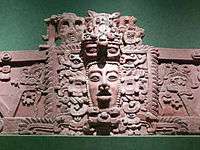Maya rulers
 |
| Maya civilization |
|---|
| History |
| Preclassic Maya |
| Classic Maya collapse |
| Spanish conquest of the Maya |
Maya kings were the centers of power for the Maya civilization. Each Maya city-state was controlled by a dynasty of kings.
Symbols of power
Maya kings and queens felt obliged to legitimize their claim to power. One of the ways to do this was to build a temple or pyramid. Tikal Temple I is a good example. This temple was built during the reign of Yik'in Chan K'awiil. Another king named K'inich Janaab' Pakal would later carry out this same show of power when building the Temple of Inscriptions at Palenque.
Succession
Maya kings cultivated godlike personas. When a ruler died and left no heir to the throne, the result was usually war and bloodshed. King Pacal's precursor, Pacal I, died upon the battlefield. However, instead of the kingdom erupting into chaos, the city of Palenque, a Maya capital city in southern Mexico, invited in a young prince from a different city-state. The prince was only eleven years old. The Temple of Inscriptions still towers today amid the ruins of Palenque, as the supreme symbol of influence and power in Palenque.
Expansion
Pacal and his predecessors not only built elaborate temples and pyramids. They expanded their city-state into a thriving empire. Under Yik'in Chan K'awiil, Tikal conquered Calakmul and the other cities around Tikal, forming what could be referred to as a super city-state. Pacal achieved in creating a major center for power and development.
Responsibilities
A Maya king was expected to be a military leader. He would often carry out raids against rival city states. The Maya kings also offered his own blood to the gods. The rulers were also expected to have a great mind to solve problems that the city might be facing, including war and food crises.
See also
- List of rulers of Copan
- List of the rulers of Dos Pilas
- Rulers of Tikal
- Yaxchilan rulers
- Maya stelae